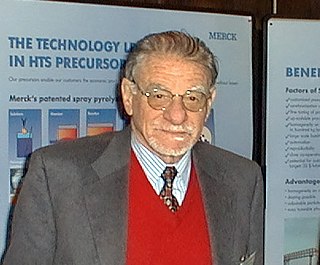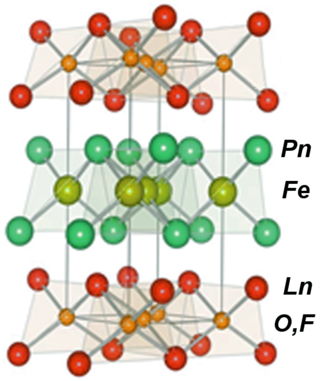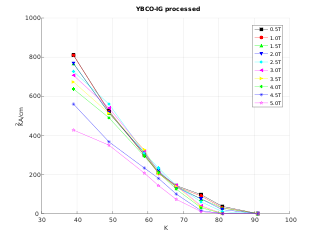Unconventional superconductors are materials that display superconductivity which does not conform to either the conventional BCS theory or Nikolay Bogolyubov's theory or its extensions.

High-temperature superconductors are defined as materials that behave as superconductors at temperatures above 77 K, the boiling point of liquid nitrogen. The adjective "high temperature" is only in respect to previously known superconductors, which function at even colder temperatures close to absolute zero. In absolute terms, these "high temperatures" are still far below ambient, and therefore require cooling. The first high-temperature superconductor was discovered in 1986, by IBM researchers Bednorz and Müller, who were awarded the Nobel Prize in Physics in 1987 "for their important break-through in the discovery of superconductivity in ceramic materials". Most high-Tc materials are type-II superconductors.
A room-temperature superconductor is a material that is capable of exhibiting superconductivity at operating temperatures above 0 °C, that is, temperatures that can be reached and easily maintained in an everyday environment. As of 2020, the material with the highest accepted superconducting temperature is an extremely pressurized carbonaceous sulfur hydride with a critical transition temperature of +15 °C at 267 GPa. On 22 September 2022, the original article reporting superconductivity in the carbonaceous sulfur hydride material was retracted by Nature journal editorial board due to a non standard, user-defined data analysis, calling into question the scientific validity of the claim.

Magnesium diboride is the inorganic compound with the formula MgB2. It is a dark gray, water-insoluble solid. The compound has attracted attention because it becomes superconducting at 39 K (−234 °C). In terms of its composition, MgB2 differs strikingly from most low-temperature superconductors, which feature mainly transition metals. Its superconducting mechanism is primarily described by BCS theory.

Yttrium barium copper oxide (YBCO) is a family of crystalline chemical compounds that display high-temperature superconductivity; it includes the first material ever discovered to become superconducting above the boiling point of liquid nitrogen at about 93 K.

In superconductivity, a type-II superconductor is a superconductor that exhibits an intermediate phase of mixed ordinary and superconducting properties at intermediate temperature and fields above the superconducting phases. It also features the formation of magnetic field vortices with an applied external magnetic field. This occurs above a certain critical field strength Hc1. The vortex density increases with increasing field strength. At a higher critical field Hc2, superconductivity is destroyed. Type-II superconductors do not exhibit a complete Meissner effect.

Johannes Georg Bednorz is a German physicist who, together with K. Alex Müller, discovered high-temperature superconductivity in ceramics, for which they shared the 1987 Nobel Prize in Physics.

Karl Alexander Müller was a Swiss physicist and Nobel laureate. He received the Nobel Prize in Physics in 1987 with Georg Bednorz for their work in superconductivity in ceramic materials.
Cuprate superconductors are a family of high-temperature superconducting materials made of layers of copper oxides (CuO2) alternating with layers of other metal oxides, which act as charge reservoirs. At ambient pressure, cuprate superconductors are the highest temperature superconductors known. However, the mechanism by which superconductivity occurs is still not understood.
Superconductors can be classified in accordance with several criteria that depend on physical properties, current understanding, and the expense of cooling them or their material.

Iron-based superconductors (FeSC) are iron-containing chemical compounds whose superconducting properties were discovered in 2006. In 2008, led by recently discovered iron pnictide compounds, they were in the first stages of experimentation and implementation..

Thallium barium calcium copper oxide, or TBCCO (pronounced "tibco"), is a family of high-temperature superconductors having the generalized chemical formula TlmBa2Can−1CunO2n+m+2.

Superconducting wires are electrical wires made of superconductive material. When cooled below their transition temperatures, they have zero electrical resistance. Most commonly, conventional superconductors such as niobium-titanium are used, but high-temperature superconductors such as YBCO are entering the market.

Lanthanum barium copper oxide, or LBCO, is an inorganic compound with the formula CuBa0.15La1.85O4. It is a black solid produced by heating an intimate mixture of barium oxide, copper(II) oxide, and lanthanum oxide in the presence of oxygen. The material was discovered in 1986 and was the first high temperature superconductor. Johannes Georg Bednorz and K. Alex Müller shared the 1987 Nobel Prize in physics for the discovery that this material exhibits superconductivity at the then unusually high temperature. This finding led to intense and fruitful efforts to generate other cuprate superconductors.
Superstripes is a generic name for a phase with spatial broken symmetry that favors the onset of superconducting or superfluid quantum order. This scenario emerged in the 1990s when non-homogeneous metallic heterostructures at the atomic limit with a broken spatial symmetry have been found to favor superconductivity. Before a broken spatial symmetry was expected to compete and suppress the superconducting order. The driving mechanism for the amplification of the superconductivity critical temperature in superstripes matter has been proposed to be the shape resonance in the energy gap parameters ∆n that is a type of Fano resonance for coexisting condensates.

Distrontium ruthenate, also known as strontium ruthenate, is an oxide of strontium and ruthenium with the chemical formula Sr2RuO4. It was the first reported perovskite superconductor that did not contain copper. Strontium ruthenate is structurally very similar to the high-temperature cuprate superconductors, and in particular, is almost identical to the lanthanum doped superconductor (La, Sr)2CuO4. However, the transition temperature for the superconducting phase transition is 0.93 K (about 1.5 K for the best sample), which is much lower than the corresponding value for cuprates.
LSAT is the most common name for the inorganic compound lanthanum aluminate - strontium aluminium tantalate, which has the chemical formula (LaAlO3)0.3(Sr2TaAlO6)0.7 or its less common alternative: (La0.18Sr0.82)(Al0.59Ta0.41)O3. LSAT is a hard, optically transparent oxide of the elements lanthanum, aluminum, strontium and tantalum. LSAT has the perovskite crystal structure, and its most common use is as a single crystal substrate for the growth of epitaxial thin films.

Rare-earth barium copper oxide is a family of chemical compounds known for exhibiting high temperature superconductivity (HTS). ReBCO superconductors have the potential to sustain stronger magnetic fields than other superconductor materials.
Bernard Raveau, born in 1940, is a French researcher in materials science, professor emeritus at the University of Caen Normandy, member of the French Academy of sciences.

Lanthanum cuprate usually refers to the inorganic compound with the formula CuLa2O4. The name implies that the compound consists of a cuprate (CuOn]2n-) salt of lanthanum (La3+). In fact it is a highly covalent solid. It is prepared by high temperature reaction of lanthanum oxide and copper(II) oxide follow by annealing under oxygen.













